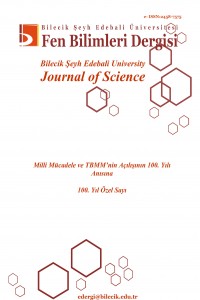Petrol-Su Ayrışma Sistemlerindeki Birleştirilmiş Plakaların Ayrışma Verimliliği Üzerindeki Etkisinin Deneysel Olarak İncelenmesi
Abstract
Petrol-su ayrışma sistemleri, sudan arındırılmış petrol elde edilmesi açısından önem taşımakla birlikte suya olan ihtiyacın arttığı günümüz koşullarında ayrışmış suyun da elde edilmesi önem taşımaktadır. Bu çalışma, petrol-su karışımlarının ayrıştırılması sistemlerinde yaygın olarak kullanılan delikli birleştirilmiş plakalar ile gerçekleştirilen bir dizi çalışma içermektedir. Farklı özelliklere sahip petrol-su karışımları üç farklı petrol sahasından alınarak ayrışma sistemine farklı hız değerlerinde (0.5, 0.7, 0.9 m/s) pompalanmıştır. Deneysel olarak yapılan bu çalışmada ölçümler 25 C’de gerçekleştirilmiştir. Deney sonucunda elde edilen ayrışmış suyun içindeki petrol oranı ölçülerek ayrışma verimlilik değerleri belirlenmiştir ve her bir numunenin üç farklı Re sayısı için petrol-su karışımının ayrışma verimliliği incelenmiştir. Elde edilen ayrışma verimlilik değerleri ile karışımın sisteme pompalanma hızı arasındaki ilişki irdelenip yorumlanmıştır. Yapılan deneyler ve analizler sonucu elde edilen ayrışma verimlilik değerinin Re sayısı ile orantılı olarak belli bir noktaya kadar arttığı daha sonra ise akış karakteristiklerinden ve uygulanan birleştirilmiş plaka geometrisinden dolayı düştüğü gözlemlenmiştir. En iyi ayrışma verimlilik değeri 2660,76 Re sayısında, başlangıçta %11 petrol içeren petrol-su karışımının kullanılmasıyla; ayrışan suda %0.5 petrol oranının ölçülmesi ile elde edilmiştir.
Supporting Institution
Van Yüzüncü Yıl Üniversitesi Bilimsel Araştırma Projeleri Koordinatörlüğü
Project Number
FOA-2019-7591
Thanks
Bu çalışma Van Yüzüncü Yıl Üniversitesi Bilimsel Araştırma Projeleri Koordinatörlüğü tarafından FOA-2019-7591 numaralı proje ile desteklenmiştir.
References
- KAYNAKLAR
- [1] Halliburton (2011). Water management [online]. http://www.halliburton.com.
- [2] James, P., Rainer, EF. (1993). Produced Water: Technological/Environmental Issue and Solutions. In Environmental Science Research, 616.
- [3] Khatib, Z., Verbeek, P. (2003). Water to Value Produced Water Management for Sustainable Field Development of Mature and Green Fields, J. Petrol Technol., Jan: 26–28.
- [4] Razi, FA., Alireza, P., Zainal, AZ., Chuah AL., Awang, BDA., Siavash, MS. (2010). Application of Membrane-Coupled Sequencing Batch Reactor for Oilfield Produced Water Recycle and Beneficial Re-Use. Bio Resource Technology, 101(18), 6942-6949.
- [5] Razi, FA., Pendashteh, A., Abdullah, LC., Biak, DRA., Madaeni, SS., Abidin, ZZ. (2009). Review of Technologies for Oil and Gas Produced Water Treatment. Journal of Hazardous Materials, 170(2–3), 530-551.
- [6] Hashim, R, Abdolhamid, A., Mars, E. (2009). Evaluation of Bio-Surfactants Enhancement on Bioremediation Process Efficiency for Crude Oil Contaminated Soil at Oilfield. Strategic Study, 20, 25-30.
- [7] John, A., Veil, Markus G., Puder, Elcock D., Robert J., Redweik, J. (2004). A White Paper Describing Produced Water from Production of Crude Oil. Natural Gas and Coal Bed Methane produced water, P0401pdf.
- [8] Zhaohui, X., Ashok, M., Wilfred, C. (2003). Detection of Benzene, Toluene, Ethylbenzene, and Xylenes (BTEX) Using Toluene Dioxygenase-Peroxidase Coupling Reactions. Biotechnology Progress, 19(6), 1812-1815.
- [9] Agency USEP. (1998). National Center for Environmental Assessment–Washington Office of Research and Development. Carcinogenic Effects of Benzene: An Update, Washington DC., 57.
- [10] Reusser, DE., Field, JA. (2002). Determination of Benzyl Succinic acid in Gasoline-Contaminated Ground Water by Solid-Phase Extraction Coupled with Gas Chromatography. Mass Spectrometry, 953, 215-225.
- [11] Gu, Y. (2001). Separation of Produced Petroleum Fluids Using a Coalescer Column. Research Proposal Submitted to Petroleum Technology Research Centre (PTRC).
- [12] Rao, TC., Patil, DP. (1998). Developments in Gravity Separation, J. Mines Metals &Fuels, 46, 383.
- [13] Ruiz, MC., Padilla, R. (1996). Separation of Liquid-Liquid Dispersion in a Deep-Layer American Chemical Society Gravity Settler, Part II Mathematical Modeling of the Settler, Hydrometallurgy, 42, 281.
- [14] Kenawy, FA., Kandil, ME., Aboarab, TW. (1997). Produced Water Treatment Technology-A Study of Oil/Water Separation in Gravity-type Cross flow Pack Separators for Qualitative Separation, SPE Prod. & F acil, 12, 112.
- [15] Morrison, J. (1970). Tilted Plate Separators for Refinery Wastewater, Oil and Gas Journal, 68(50), 80-86.
- [16] Kok, DF., Marson, HW. (1978). Tanker Ballast Water Meets Through Treating Specs, Oil and Gas Journal, 76(49), 7-92.
- [17] Mohr, KS. (1993). A New Type of High Efficiency Oil-Water Separator for Better Water Quality Management, Submitted to The Faculty of The Graduate College of The Oklahoma State University in Partial Fulfillment of The Requirements for The Degree of Master of Science. December, 1993.
- [18] Algifri, AH., Bhardwaj, RK., Rao, YVN. (1988). Turbulence Measurements in Decaying Swirl Flow in A Pipe. Applied Scientific Research, January 1988, 45, 233-250.
- [19] Escobar, OM. (2005). The Graduate School Performance Evaluation of Modified Liquid-Liquid Cylindrical Cyclone. Petroleum Engineering the Graduate School the University of Tulsa.
- [20] Guerin, TF. (2002). Heavy Equipment Maintenance Wastes and Environmental Management in The Mining Industry. J. Environ. Manage, 66, 185–199.
- [21] Yayla, S., Olcay, A.B., Ibrahim, S.S. (2017). Numerical Investigation of Coalescing Plate System to Understand the Separation of Water and Oil in Water Treatment Plant of Petroleum Industry, Engineering Applications of Computational Fluid Mechanics, 11(1), 184-192.
Details
| Primary Language | Turkish |
|---|---|
| Subjects | Engineering |
| Journal Section | Articles |
| Authors | |
| Project Number | FOA-2019-7591 |
| Publication Date | March 23, 2020 |
| Submission Date | December 11, 2019 |
| Acceptance Date | February 11, 2020 |
| Published in Issue | Year 2020 Volume: 7 Issue: 100. Yıl Özel Sayı |

